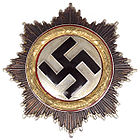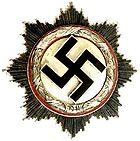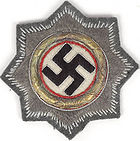- German Cross
-
This article is about the military decoration. For the symbol of the German armed forces, see Iron Cross.
German Cross
Deutsches Kreuz

German Cross in Gold (left) and Silver (right)Awarded by Nazi Germany Type Badge Eligibility Military personnel Awarded for The Gold division was awarded to military personnel for 6-8 exceptional acts of bravery or achievements in combat. Silver division was awarded for distinguished acts of service in war effort. Campaign World War II Status Obsolete Statistics Established 28 September 1941 Total awarded ~26,000 in Gold
~ 2,500 in Silver
German Cross in Silver and GoldThe German Cross (German: Deutsches Kreuz) was instituted by Adolf Hitler on 17 November 1941 as an award ranking higher than the Iron Cross First Class but below the Knight's Cross of the Iron Cross respectively ranking higher than the War Merit Cross First Class with Swords but below the Knight's Cross of the War Merit Cross with Swords.
The German Cross was issued in two divisions: gold and silver (the color of the laurel wreath around the swastika), the former being an award for repeated acts of bravery or repeated outstanding achievements in combat, the latter being for multiple distinguished services in war efforts and was considered a continuation of the War Merit Cross with swords. The German Cross was unique in that the Gold and Silver divisions were considered as separate awards but should not be worn simultaneously. However, pictures of recipients wearing both grades exist (see Odilo Globocnik and Dr. Paul Meixner). There are a total of 14 recorded instances of a German recipient receiving both the German Cross in Silver (GCiS) and Gold (GCiG) during the war. These are:
• Major General Robert Bader GCiG 18.03.1945 & GCiS 14.02.1943,
• Lieutnant Colonel Jürgen Bennecke GCiG 30.01.1945 & GCiS 15.02.1943,
• Major General Wolfgang Bucher GCiG 23.02.1944 & GCiS 14.02.1943,
• Colonel Hans Hecker GCiG 19.02.1942 & GCiS 19.02.1942,
• SS-Gruppenführer and Lieutnant General of the Police Odilio L. Glo-bocnik GCiG 07.02.1945 & GCiS 20.01.1945,
• Major Franz Kaiser GCiG 01.0311945 & GCiS 08.07.1943,
• Rear Admiral Dr. Paul H. Meixner GCiG 11.02.1943 & GCiS 06.06.1942,
• Major General Ernst Merk GCiG 11.02.1944 & GCiS 06.06.1942,
• Lieutnant Colonel Helmut Moeller-Althaus GCiG 15.12.1943 & GCiS 30.05.1942,
• SS-Standartenführer and Colonel of the Police Walther Rauff GCiG 07.02.1945 & GCiS 20.05.1943,
• General Felix Schwalbe GCiG 07.12.1944 & GCiS 30.10.1943,
• Lieutnant General Alfred Thielmann GCiG 08.11.1944 & GCiS 03.12.1942,
• Rear Admiral Paul W. Zieb GCiG 28.09.1944 & GCiS 18.05.1944 and
• Lieutnant General Bodo Zimmermann GCiG 25.09.1944 & GCiS 15.02.1943.
The following 22 foreign soldiers from the allied armed forces got the German Cross in Gold awarded:
• Croatia: Lieutnant Cvitan Galić, 1st Lieutnant Mato Dukovac,
• Finland: General Axel Erik Heinrichs 17.08.1943, Lieutnant General Jarl Fritjof Lundquist 09.11.1943, Lieutnant General Väinö Valve 03.05.1944, Lieutnant General Taavetti Laatikainen 05.08.1944, Lieutnant General Karl Lennart Oesch 05.08.1944,
• Italia: Vice Admiral Luigi Sansonetti18.01.1942, Marshal Ettore Bastico 05.12.1942, General Enea Navarini 21.12.1942, Admiral Arturo Riccardi 18.01.1943, Colonel General Rino Corso Fougier 18.01.1943, Colonel Mario Carloni 28.03.1943,
• Romania: General Gheorghe Avramescu 25.10.1942, Major General Leonard Mociulschi 25.10.1942, Major General Ermil Gheorghiu 11.02.1943, Captain Nicolae Dabija 10.02.1944), • Slovakia: Sergeant Izidor Kovarík 17.10.1943, Sergeant Ján Režňák 17.10.1943 and
• Spain: Major don Angel Salas Larrazabal 09.02.1942, Major General Emilio Estéban Infantes y Martín 09.04.1943, Colonel Antonio Garcia Navarro 23.03.1944.
And some 26 non German volunteers of the Waffen-SS from Belgium, Denmark, Estonia, Finland, Hungaria, Latvia, Netherlands and Norway received the German Cross in Gold.
Specimen copies of a special grade, the German Cross in Gold with Diamonds, was manufactured in 1942 but this grade was never instituted and bestowed.
The order consists of a star badge, containing a swastika (in German, Hakenkreuz, "hooked cross", which gives the award its name, the "German cross"). It had a diameter of 6.5 cm and was worn on the righthand pocket of the tunic. If a recipient was awarded both the silver and gold divisions, both of them could not be worn on the uniform.
Only the golden division of the award was officially also available in cloth form, which was made for easier wear on the combat uniform; General Helmuth Weidling wore this variety during his defense of Berlin in April–May 1945. Far more awards in gold (combat) were presented than in silver (support).
The cross title refers to the fact that the swastika is a cross, a sun-cross.
In 1957 alternative 'de-nazified' replacement versions of the German Cross were authorised for wear by the Federal Republic of Germany. This replaced the swastika with a representation of the Iron Cross for the gold division, and the War Merit Cross with Swords for the silver division. Wear of Nazi era decorations has been banned in Germany after the war, as is any display of the swastika. Veterans who had earned the German Cross during the Third Reich were therefore unable to wear it before this change. The wearing of Nazi era decorations in any form continued to be banned in the German Democratic Republic.
References
- For Führer And Fatherland: Military Awards of the Third Reich by LTC John R. Angolia. 1976 R. James Bender Publishing. ISBN 0-912138-14-9
- "The German Cross in Gold and Silver" by Dietrich Maerz, B&D Publishing LLC, Richmond, MI, 2009, ISBN 978-0-9797969-2-0
Categories:- Orders, decorations, and medals of Nazi Germany
- Military awards and decorations of Germany (Wehrmacht)
Wikimedia Foundation. 2010.

